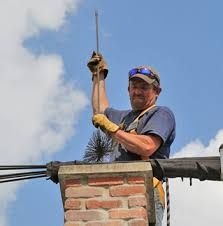Complete Guide to Chimney Sweep and Inspection Care
A fireplace might be the most comfortable room in any residence, but it also has some behind-the-scenes duties. Any fire you light deposits material in your chimney, and after a while, this debris can be hazardous. Throw in storm damage, animal habitats, or hidden cracks, and your chimney isn’t safe anymore. That’s why homeowners require two fundamental services: chimney sweep and chimney inspection.
Whereas sweeping eliminates dangerous debris, inspections reveal structural problems you can’t see. Combined, they’re the building blocks of a safe and effective fireplace system. This report discusses why both services are needed, how often to have them done, and what homeowners can expect at each visit.
The Role of a Chimney Sweep
Chimney sweep refers to the cleaning that eliminates soot, ash, and creosote from the flue. Creosote is the largest concern because it’s extremely flammable and a major cause of chimney fires. A thin layer can be ignited under extreme heat.
Sweeping also removes:
Bird nests, leaves, or other obstructions.
Obstructions that restrict proper venting of smoke.
Excess soot that decreases heating efficiency.
By maintaining a clear chimney, sweeping ensures your fireplace burns more efficiently, consumes less fuel, and safely expels gases outside.
Why Chimney Inspections Are as Important
Cleaning is only half the battle. Structural issues within the chimney are usually not detected until significant problems arise. That’s where expert inspections come in.
An inspection verifies:
Cracks or damage within the flue liner.
Loose or missing mortar and bricks.
Water damage or leaks.
Carbon monoxide leakage hazards.
Chimney cap and crown condition.
Without routine inspections, minor issues soon turn into costly repairs. Worse still, they endanger your home and loved ones.
How Often Should You Plan Each Service?
Professionals suggest adopting these general guidelines:
Chimney sweep: At least once a year, more frequently if you have a regular wood-burning schedule.
Chimney inspection: Also once a year, preferably before the burning season starts.
If you have a daily winter use of your fireplace, or if you burn softwood that creates more creosote, you might clean twice a year. And if your chimney has been subject to storms, earthquakes, or other damage, an additional inspection is necessary.
Levels of Chimney Inspection
Not all chimneys require the same level of examination. The National Fire Protection Association (NFPA) recognizes three types:
Level 1 – Simple visual inspection, adequate for normal servicing.
Level 2 – Adds video scanning and attic or crawlspace inspection; used when selling a house or following a chimney fire.
Level 3 – Most extensive, at times necessitating removal of sections of the chimney or walls to evaluate extreme damage.
A professional will advise the appropriate level depending on your case.
What Happens During a Service Visit?
When you plan to have a sweep and inspection together, this is what happens:
Preparation – The furniture and floor around the fireplace are covered against dust.
Initial inspection – The chimney technician inspects the structure for apparent problems.
Sweeping – Brushes and vacuums remove soot, creosote, and debris from the flue.
Detailed inspection – Equipment such as cameras is used to inspect the liner, crown, and cap.
Report and advice – You receive a summary of the chimney’s condition and recommendations for any repairs.
The process usually takes 1–2 hours, and modern equipment ensures a clean, efficient job.
Signs You Need Immediate Attention
Even if you follow yearly maintenance, some warning signs mean you should call a professional sooner:
Smoke backing into your home.
Strong odors from the fireplace.
Visible cracks or white staining on the chimney exterior.
Uncontrolled creosote accumulation (new shiny black glaze on interior surface).
Falling fragments of brick, tile, or mortar.
Failure to heed these warning signs may lead to fire risks or expensive structural damage.
Prices for Chimney Sweep and Inspection
Generally, homeowners can expect to pay:
Chimney sweep: $100–$300 based on size and buildup.
Inspection: $75–$400 based on level needed.
Though these services are paid, they are significantly cheaper than having to fix fire damage, replace a chimney liner, or rebuild a fallen chimney.
Advantages of Both Sweep and Inspection Combined
Homeowners schedule only one visit for some, but both services are the most effective protection.
Comprehensive care: Cleaning ensures safe combustion airflow, while inspection detects unseen hazards.
Efficiency: A properly cleaned, well-serviced chimney combusts fuel more efficiently and saves energy.
Long-term savings: Avoiding little problems from turning into big repairs saves you money.
Peace of mind: You can relax in front of your fireplace, knowing your system is in good condition.
Homeowner Tips
To get your chimney into top shape all year long:
Burn seasoned hardwood rather than softwood to minimize creosote buildup.
Install a chimney cap to keep animals, leaves, and rain out.
Schedule maintenance before winter, when chimney companies have slower schedules.
Maintain a record of every sweep and inspection for your home’s maintenance history.
Following these simple steps, supplemented with professional care, adds years to the life of your chimney.
Conclusion
A fireplace brings warmth and ambiance, but it also brings responsibilities. Without frequent sweeping and inspection, your chimney can become an unseen danger. Soot, creosote, and structural damage all accumulate silently until they result in expensive or even life-threatening issues.
By having chimney sweep and chimney inspection services scheduled annually, homeowners can avoid fire risks, enhance heating performance, and save their investment. Together, cleaning and inspection have your fireplace in working condition whenever you want it—safe, efficient, and reliable.
Don’t wait until you notice something’s wrong. Schedule a professional chimney sweep and inspection today, and bask in the confidence that your home is secure.
Read more Chimney sweep




Leave a Reply
Want to join the discussion?Feel free to contribute!